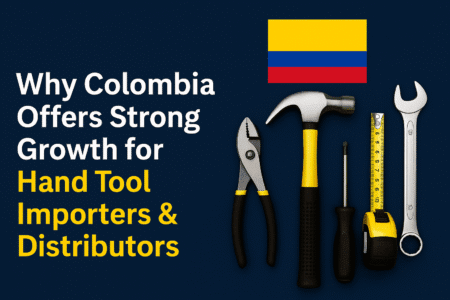
Introduction
Colombia, a country long recognized for its vibrant economy and growing infrastructure, is emerging as a promising hub for the hand tools industry in 2025. Positioned strategically in South America with strong trade ties to both North America and Europe, Colombia has become an attractive market for global exporters, importers, and distributors of hand tools.
With a robust construction sector, expanding automotive industry, and a fast-growing network of small-scale workshops and DIY consumers, Colombia’s demand for reliable, affordable, and durable hand tools is steadily increasing. For importers and distributors, this offers not just sales growth but also opportunities to establish long-term partnerships with global suppliers.
This article explores why Colombia is becoming a key growth destination for the hand tools industry, examining its market trends, supply chain, opportunities for exporters, and business strategies for importers and distributors.
Colombia Hand Tools Market Overview 2025
The Colombian hand tools market is being driven by several factors:
- Industrial Growth: Colombia’s economy is expected to grow steadily, with construction and infrastructure development projects fueling demand for wrenches, pliers, hammers, clamps, and power tool accessories.
- Automotive Demand: As one of the top car ownership countries in South America, Colombia has thousands of service workshops and repair centers, all requiring professional-grade hand tools.
- DIY & Retail Expansion: An increasing middle-class population is fueling growth in the DIY (Do-It-Yourself) sector, leading to higher sales of basic hand tools through retail and e-commerce.
- Import Reliance: Colombia imports a majority of its hand tools, primarily from China, India, the United States, and European countries, making it highly dependent on reliable global suppliers.
According to trade data, Colombia’s import of hand tools has been growing at 8–12% annually, reflecting both domestic demand and regional redistribution to neighboring markets like Ecuador, Peru, and Panama.
Key Hand Tool Exporters Supplying Colombia
Colombia sources its tools from multiple international exporters. Each region plays a different role in shaping the supply chain:
1. Indian Exporters
- India is a rising supplier of forged steel tools, spanners, pliers, hammers, wrenches, and tool kits.
- Known for durability, cost-effectiveness, and OEM (private label) partnerships, Indian suppliers are becoming a preferred choice for Colombian distributors who want quality at competitive prices.
- Exporters like Eastman Cast & Forge Ltd., Taparia Tools, and other OEM manufacturers have already made inroads into Latin America.
2. Chinese Exporters
- China continues to dominate in low-cost bulk shipments, making it appealing to budget-focused importers and hardware retailers.
- However, Colombian distributors are gradually shifting toward mid-tier premium tools as demand for longer-lasting products rises.
3. U.S. & European Exporters
- Premium brands like Stanley, DeWalt, Bosch, and Gedore are strong players in Colombia.
- These are widely used in industrial projects but remain more expensive, catering to professional users rather than mass-market consumers.
Hand Tool Importers & Distributors in Colombia
Importers and distributors are the lifeline of Colombia’s hand tools industry, ensuring global products reach local businesses and end users.
Role of Importers
- Handle international sourcing, certifications, customs clearance, and logistics.
- Work with exporters on bulk procurement, private labeling, and long-term contracts.
- Often serve as regional hubs, redistributing tools to Ecuador, Peru, and Central America.
Role of Distributors & Wholesalers
- Supply hand tools to hardware stores, construction retailers, e-commerce platforms, and B2B buyers.
- Build networks with workshops, factories, mechanics, and contractors.
- Create strong after-sales support and brand awareness at the ground level.
Characteristics of Colombian Importers
- They prefer reliable supply chains with steady availability.
- Increasingly interested in OEM/white-label tools to establish their own brands.
- Looking for suppliers who provide certifications (ISO, DIN, ANSI).
Distribution & Supply Chain Insights
The Colombian supply chain for hand tools follows a structured flow:
- Exporters ship goods into Colombian ports like Cartagena and Buenaventura.
- Importers handle customs clearance and national distribution.
- Distributors & wholesalers supply to regional hardware markets in Bogotá, Medellín, Cali, and Barranquilla.
- Retail stores, workshops, and e-commerce channels deliver products to end-users (construction workers, mechanics, and DIY consumers).
🔑 Opportunity: Importers who align with exporters offering bulk pricing, marketing support, and flexible supply terms can expand their distributor networks quickly.
Opportunities for Global Exporters in Colombia
The Colombian market presents multiple business opportunities for global exporters:
- Construction Boom – Colombia’s growing urban development creates steady demand for clamps, pliers, hammers, spanners, and saws.
- Automotive Industry Growth – Thousands of small and medium auto repair shops require socket sets, torque wrenches, and tool kits.
- DIY & Retail Market – Expanding middle-class households are driving sales of general-use tools via retail chains and e-commerce.
- OEM Partnerships – Colombian importers are increasingly seeking exclusive brand partnerships with exporters to create local private labels.
- Regional Distribution – With strong trade links, Colombia serves as a gateway to Latin America, making it an ideal hub for exporters to expand.
Why Colombia Offers Strong Growth for Importers & Distributors
There are several key reasons why Colombia is considered a growth hub:
- Growing Demand: Industrial and residential growth are pushing tool consumption higher.
- Strategic Location: Colombia connects South America with Central and North America, making it a regional distribution center.
- Supportive Trade Policies: Colombia has multiple Free Trade Agreements (FTAs) with the U.S., EU, and other nations, reducing tariffs on tools.
- Import Dependency: Limited domestic production means importers and distributors will continue to dominate supply chains.
- Preference for Quality: Colombian businesses are shifting from cheap disposable tools to longer-lasting, branded hand tools.
How Importers & Distributors Can Succeed in Colombia
For businesses looking to grow in this market, success depends on building trust, visibility, and strong partnerships.
- Partner with Reliable Exporters: Focus on suppliers who offer consistent quality, certifications, and OEM services.
- Leverage Trade Shows: Events in Bogotá and Medellín attract global suppliers and local buyers.
- Embrace E-Commerce: Platforms like Mercado Libre and local B2B marketplaces are growing sales channels.
- Offer After-Sales Support: Distributors who provide warranty and technical guidance will stand out.
- Build Regional Networks: Colombia’s geography makes it ideal for serving Peru, Ecuador, and Panama with hand tool exports.
Why Indian Hand Tool Exporters Are Well-Positioned
Indian manufacturers have a unique edge in the Colombian market:
- Product Strengths: Forged steel tools, CR-V spanners, precision pliers, hammers, wrenches.
- Competitive Pricing: More affordable than European brands but more durable than cheaper Chinese imports.
- Certifications: Many Indian suppliers are ISO and DIN compliant, meeting international standards.
- OEM Potential: Indian exporters often provide custom branding and packaging, which Colombian importers demand.
Example: Eastman Cast & Forge Ltd. is already exporting to Latin America, offering a wide portfolio of tools that suit both professional users and retail buyers.
Future Outlook – Colombia Hand Tools Market Beyond 2025
Looking ahead, Colombia is expected to remain a growth hotspot for hand tools.
- Digital Transformation: More tools will be sold through online B2B and B2C platforms.
- Ergonomic & Smart Tools: The market will shift toward ergonomically designed, multi-purpose, and smart tools.
- Regional Role: Colombia will solidify its role as a distribution hub for Latin America.
- Sustainability: Eco-friendly packaging and durable tools will be key selling points.
By 2030, Colombia’s hand tool imports are projected to nearly double, making it one of the most important markets for global exporters and distributors.
Conclusion
Colombia’s hand tools industry is entering a high-growth phase, driven by construction, automotive, and DIY markets. For importers and distributors, the opportunities lie in partnering with reliable global exporters, embracing OEM models, and building strong regional networks.
- Exporters benefit from Colombia’s import reliance and trade-friendly policies.
- Importers gain by sourcing durable, certified tools that meet growing local demand.
- Distributors expand by serving both local buyers and regional markets.
👉 In 2025 and beyond, Colombia truly offers strong growth for hand tool importers and distributors, making it a market that global players cannot afford to ignore.























